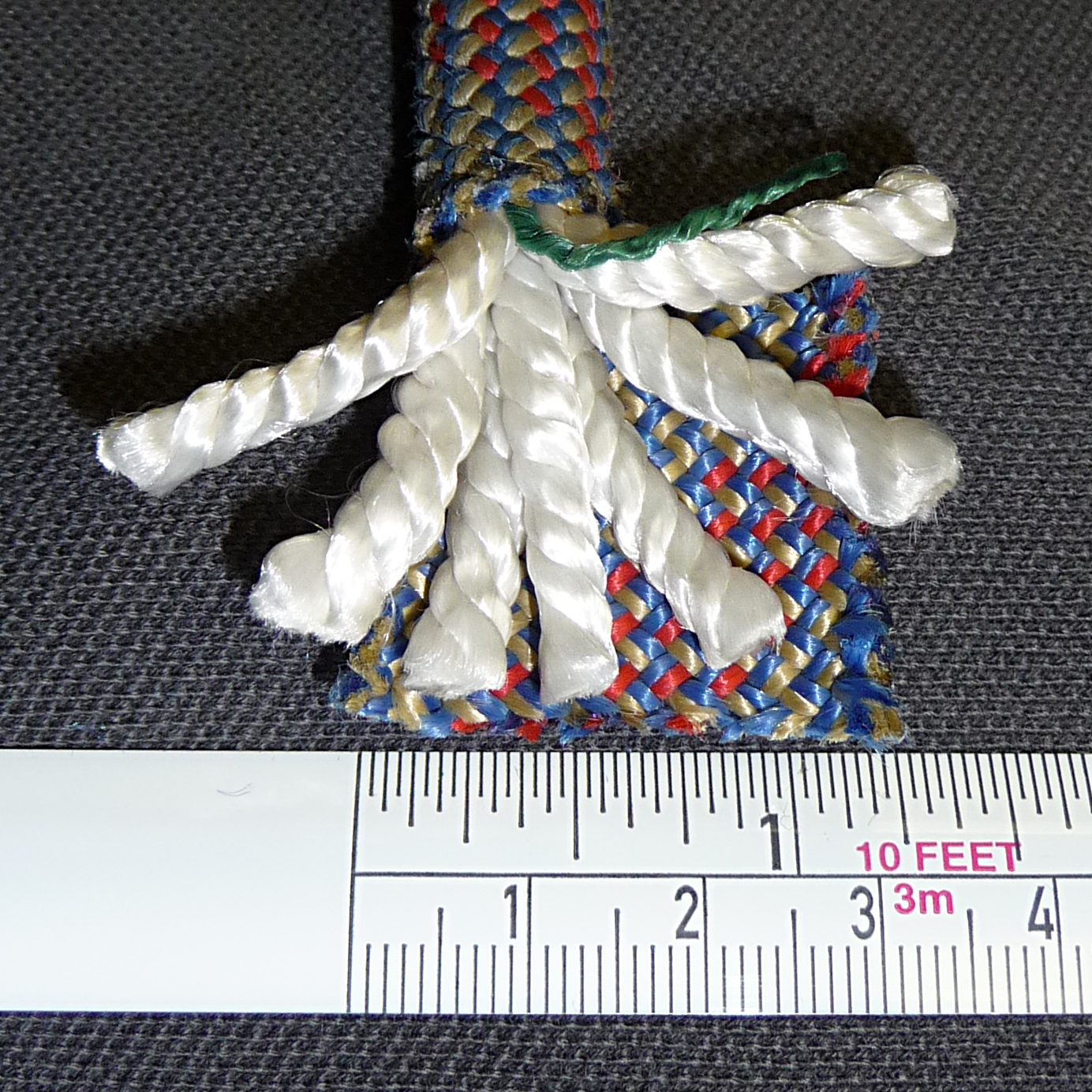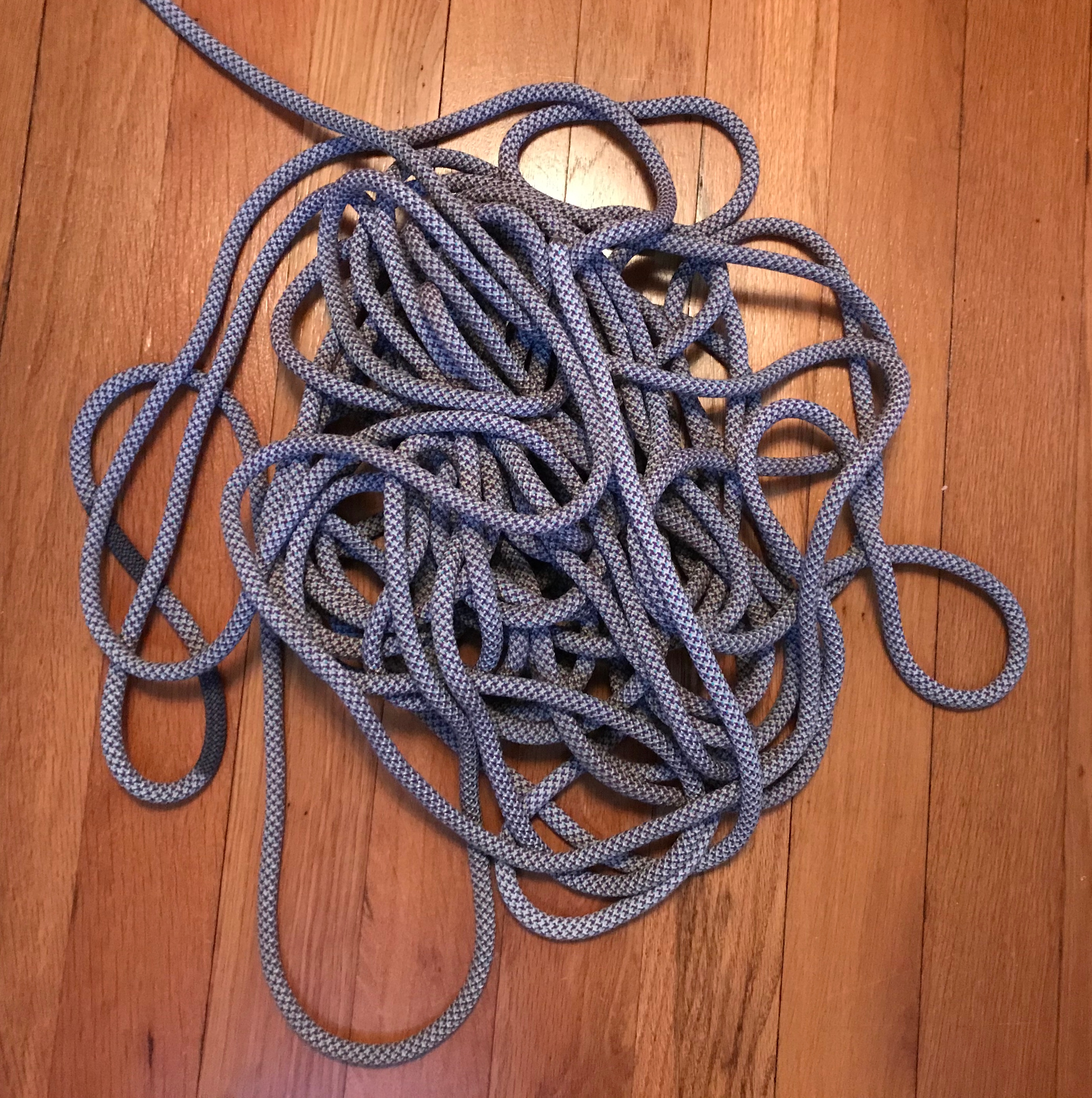|
Kernmantle Rope
Kernmantle rope () is rope constructed with its interior core protected by a woven exterior sheath designed to optimize strength, durability, and flexibility. The core fibers provide the tensile strength of the rope, while the sheath protects the core from abrasion during use. This is the only construction of rope that is considered to be life safety rope by most fire and rescue services. Parachute cord Parachute cord (also paracord or 550 cord when referring to type-III paracord) is a lightweight nylon kernmantle rope originally used in the suspension lines of parachutes. This cord is useful for many other tasks and is now used as a general purpose utility cord by both military personnel and civilians. Use as climbing rope One of the uses of kernmantle rope is as climbing rope. Nylon ropes that were used in yachts for hauling were tested and found useful in climbing and caving and are now the modern standard. The German company Edelrid introduced the first kernmantel rope ... [...More Info...] [...Related Items...] OR: [Wikipedia] [Google] [Baidu] |
Rope
A rope is a group of yarns, plies, fibres, or strands that are twisted or braided together into a larger and stronger form. Ropes have tensile strength and so can be used for dragging and lifting. Rope is thicker and stronger than similarly constructed cord, string, and twine. Construction Rope may be constructed of any long, stringy, fibrous material, but generally is constructed of certain natural or synthetic fibres. Synthetic fibre ropes are significantly stronger than their natural fibre counterparts, they have a higher tensile strength, they are more resistant to rotting than ropes created from natural fibres, and they can be made to float on water. But synthetic ropes also possess certain disadvantages, including slipperiness, and some can be damaged more easily by UV light. Common natural fibres for rope are Manila hemp, hemp, linen, cotton, coir, jute, straw, and sisal. Synthetic fibres in use for rope-making include polypropylene, nylon, polyesters (e.g. ... [...More Info...] [...Related Items...] OR: [Wikipedia] [Google] [Baidu] |
Static Rope
A static rope is a low-elongation rope that is designed to stretch minimally when placed under load, typically less than 5%. In contrast, a dynamic rope is designed to stretch up to 40%. Static ropes have a wide variety of uses, for instance in fire rescue operations and caving. Static ropes have some applications in climbing, such as hauling gear, though lead climbing is always done with a dynamic rope, since a fall on a static rope is stopped too quickly and may lead to serious injury. Abseiling, however, is best done with a static rope or with a dynamic rope with low elasticity. See also *Kernmantle rope Kernmantle rope () is rope constructed with its interior core protected by a woven exterior sheath designed to optimize strength, durability, and flexibility. The core fibers provide the tensile strength of the rope, while the sheath protects the ... References * Climbing equipment Ropes {{Climbing-stub ... [...More Info...] [...Related Items...] OR: [Wikipedia] [Google] [Baidu] |
Ropes
A rope is a group of yarns, plies, fibres, or strands that are twisted or braided together into a larger and stronger form. Ropes have tensile strength and so can be used for dragging and lifting. Rope is thicker and stronger than similarly constructed cord, string, and twine. Construction Rope may be constructed of any long, stringy, fibrous material, but generally is constructed of certain natural or synthetic fibres. Synthetic fibre ropes are significantly stronger than their natural fibre counterparts, they have a higher tensile strength, they are more resistant to rotting than ropes created from natural fibres, and they can be made to float on water. But synthetic ropes also possess certain disadvantages, including slipperiness, and some can be damaged more easily by UV light. Common natural fibres for rope are Manila hemp, hemp, linen, cotton, coir, jute, straw, and sisal. Synthetic fibres in use for rope-making include polypropylene, nylon, polyesters (e.g. PET ... [...More Info...] [...Related Items...] OR: [Wikipedia] [Google] [Baidu] |
Mountaineering Equipment
A wide range of equipment is used during rock or any other type of climbing that includes equipment commonly used to protect a climber against the consequences of a fall. Rope, cord and webbing Climbing ropes are typically of kernmantle construction, consisting of a core (kern) of long twisted fibres and an outer sheath (mantle) of woven coloured fibres. The core provides about 70% of the tensile strength, while the sheath is a durable layer that protects the core and gives the rope desirable handling characteristics. Ropes used for climbing can be divided into two classes: dynamic ropes and low elongation ropes (sometimes called "static" ropes). Dynamic ropes are designed to absorb the energy of a falling climber, and are usually used as belaying ropes. When a climber falls, the rope stretches, reducing the maximum force experienced by the climber, their belayer, and equipment. Low elongation ropes stretch much less, and are usually used in anchoring systems. They are al ... [...More Info...] [...Related Items...] OR: [Wikipedia] [Google] [Baidu] |
Climbing Equipment
A wide range of equipment is used during rock or any other type of climbing that includes equipment commonly used to protect a climber against the consequences of a fall. Rope, cord and webbing Climbing ropes are typically of kernmantle construction, consisting of a core (kern) of long twisted fibres and an outer sheath (mantle) of woven coloured fibres. The core provides about 70% of the tensile strength, while the sheath is a durable layer that protects the core and gives the rope desirable handling characteristics. Ropes used for climbing can be divided into two classes: dynamic ropes and low elongation ropes (sometimes called "static" ropes). Dynamic ropes are designed to absorb the energy of a falling climber, and are usually used as belaying ropes. When a climber falls, the rope stretches, reducing the maximum force experienced by the climber, their belayer, and equipment. Low elongation ropes stretch much less, and are usually used in anchoring systems. They are al ... [...More Info...] [...Related Items...] OR: [Wikipedia] [Google] [Baidu] |
Caving Equipment
Caving equipment is equipment used by cavers and speleologists to aid and protect them while exploring caves. The term may also be used to refer to equipment used to document caves, such as photographic and surveying equipment. Originally, cave diving equipment was quite limited, but the increasing popularity of caving during the 20th century led to the creation of specialist caving equipment and companies. Due to the greatly varying conditions of caves throughout the world there is a multitude of different equipment types and categories. Cavers exploring a largely dry system may wear a fleece one-piece undersuit with a protective oversuit while cavers exploring a very wet cave may opt to use wetsuits. Cavers in large dry systems in the tropics and in desert climates may simply opt to wear shorts and a T-shirt. History The earliest cavers in Europe and North America were limited in their explorations by a lack of suitable equipment. Explorers of the early 1800s, when caving beg ... [...More Info...] [...Related Items...] OR: [Wikipedia] [Google] [Baidu] |
Detergent
A detergent is a surfactant or a mixture of surfactants with cleansing properties when in dilute solutions. There are a large variety of detergents, a common family being the alkylbenzene sulfonates, which are soap-like compounds that are more soluble in hard water, because the polar sulfonate (of detergents) is less likely than the polar carboxylate (of soap) to bind to calcium and other ions found in hard water. Definitions The word ''detergent'' is derived from the Latin adjective ''detergens'', from the verb ''detergere'', meaning to wipe or polish off. Detergent is a surfactant or a mixture of surfactants with cleansing properties when in dilute solutions. However, conventionally, detergent is used to mean synthetic cleaning compounds as opposed to ''soap'' (a salt of the natural fatty acid), even though soap is also a detergent in the true sense. In domestic contexts, the term ''detergent'' refers to household cleaning products such as ''laundry detergent'' or '' dish ... [...More Info...] [...Related Items...] OR: [Wikipedia] [Google] [Baidu] |
Bleach
Bleach is the generic name for any chemical product that is used industrially or domestically to remove color (whitening) from a fabric or fiber or to clean or to remove stains in a process called bleaching. It often refers specifically, to a dilute solution of sodium hypochlorite, also called "liquid bleach". Many bleaches have broad spectrum bactericidal properties, making them useful for disinfecting and sterilizing. They are used in swimming pool sanitation to control bacteria, viruses, and algae, and in many places where sterile conditions are required. They are also used in many industrial processes, notably in the bleaching of wood pulp. Bleaches also have other minor uses like removing mildew, killing weeds, and increasing the longevity of cut flowers. Bleaches work by reacting with many colored organic compounds, such as natural pigments, and turning them into colorless ones. While most bleaches are oxidizing agents (chemicals that can remove electrons from other ... [...More Info...] [...Related Items...] OR: [Wikipedia] [Google] [Baidu] |
Washing Machine
A washing machine (laundry machine, clothes washer, washer, or simply wash) is a home appliance used to wash laundry. The term is mostly applied to machines that use water as opposed to dry cleaning (which uses alternative cleaning fluids and is performed by specialist businesses) or ultrasonic cleaners. The user adds laundry detergent, which is sold in liquid or powder form, to the wash water. History Washing by hand Laundering by hand involves soaking, beating, scrubbing, and rinsing dirty textiles. Before indoor plumbing, individuals also had to carry all the water used for washing, boiling, and rinsing the laundry from a pump, well, or spring. Water for the laundry would be hand carried, heated on a fire for washing, then poured into the tub. That made the warm soapy water precious; it would be reused, first to wash the least soiled clothing, then to wash progressively dirtier laundry. Removal of soap and water from the clothing after washing was a separate process. Fi ... [...More Info...] [...Related Items...] OR: [Wikipedia] [Google] [Baidu] |
Chain Sinnet
A chain sinnet (or chain sennit) is a method of shortening a rope or other cable while in use or for storage. It is formed by making a series of simple crochet-like stitches in the line.Clifford W. Ashley, ''The Ashley Book of Knots'' (New York: Doubleday, 1944), 209. It can also reduce tangling while a rope is being washed in a washing machine. Tying To tie: #Create a loop in the rope. Then pull a bight of the working part through the loop, creating an overhand noose knot. #Pull another bight of the working part through the loop of the previous stitch. #Tighten the stitch to the desired degree by pulling on both sides of the loop. Adjust the loop by pulling on the working end to keep it a reasonable size. #Repeat steps 2–3 until the rope has been sufficiently shortened. #To lock the sinnet, pass the working end through the final loop. To restore the rope to its original length, pull the end passed in the last step back through the final loop and pull on the free end. Th ... [...More Info...] [...Related Items...] OR: [Wikipedia] [Google] [Baidu] |







